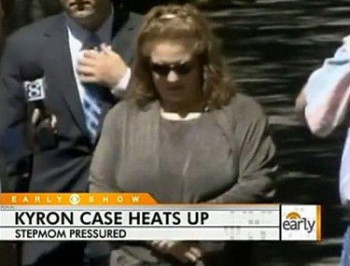
DeDe Spicher, pictured above in a screenshot from a CBS program posted on YouTube, hasn't been charged with any crime, but the media coverage of her friend Terri Horman's stepson's disappearance has suggested she or her friend may be responsible. (Credit: CBS News, YouTube)
The media frenzy this summer surrounding the disappearance of 7-year-old Kyron Horman in Portland, Ore., and the suspicion being focused on his stepmother, Terri Horman, is but the latest example of a tawdry trend in journalism that I call “trial by media.”
For anyone who hasn’t spent this summer in a cave, Kyron Horman disappeared on June 4; he was last seen walking into scmsthool after being dropped off by his stepmother, whom the media have effectively charged, indicted, tried and convicted. Now the media “investigation” is including her friend, DeDe Spicher.
Journalistic faux pas involve more than spelling and typographical errors and factual inaccuracies. They also involve editorial errors in judgment, which are far more serious because they are deliberate rather than unintentional and are often at variance with the Society of Professional Journalists’ Code of Ethics.
The news reports often dutifully state that “no charges have been filed” and that Horman and Spicher have”not been named as suspects.”
Why, then, the media frenzy, flagrantly flouting the principle of presumption of innocence, implying Horman is responsible for Kyron’s disappearance?
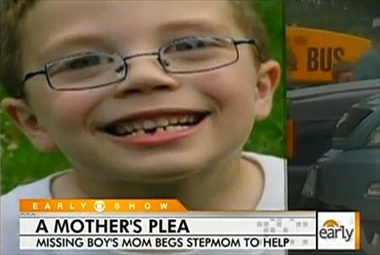 This screenshot from a CBS News’ Early Show report shows that reporting on 7-year-old boy Kyron Horman suggests that his stepmother, Terri Horman, is responsble for his disappearance. But, Terri Horman hasn’t been named a suspect by the police. (Credit: CBS News, YouTube) |
To be sure, the “evidence” the police have leaked to the media—a likewise tawdry practice of law enforcement agencies to smoke out possible suspects by applying the pressure of negative publicity—is damning.
For example, according to her estranged husband, Kaine Horman, who filed for divorce, she tried to hire someone to kill him. The media went nuts with that allegation. Has she been charged with conspiracy to commit murder? No.
I’ve seen Terri Horman’s in-laws interviewed on the morning infotainment programs, NBC’s “Today” and ABC’s “Good Morning America,” saying they are sure Terri Horman is responsible for Kyron’s disappearance. No representative of Terri Horman was interviewed.
More damning still, Horman hasn’t consented to interviews and hasn’t denied she did something with the kid, so that must mean she’s guilty, right?
Not in a real trial it wouldn’t, where she would have the right to remain silent and not incriminate herself, but it does suggest guilt in trial by media.
When I was starting out in this business, as a police reporter first for a semi-weekly and then a daily in the Fort Worth-Dallas area in the late ‘60s and early ‘70s, the then-competing newspapers had a time-honored rule that suspects were not named in print unless the district attorney’s office filed formal charges. Mere arrests were not enough. Sometimes that meant that if charges were filed an hour after deadline, the morning or evening competitor would be first to use the name. So be it.
But as the decades went by, not only did it become more common to see the names of arrested, but uncharged, suspects published or broadcast, but national media, especially the semi-tabloid morning news programs, got into the business of speculating on people’s guilt, often with the complicity of law enforcement authorities who used the media as a cat’s paw to pressure someone into breaking and confessing.
I became so concerned by this trend that when I participated in the rewriting of the SPJ Code of Ethics in June 1996, I succeeded in having the Ethics Committee agree to two clauses under the heading “Minimize Harm:”
- Be judicious about naming criminal suspects before the formal filing of charges.
- Balance a criminal suspect’s fair trial rights with the public’s right to know.
Just a month later, the country was treated to the most infamous case of trial by media to date after a pipe bomb exploded at Centennial Olympic Park in Atlanta, killing two people and injuring more than a hundred. After a few days, the FBI leaked to the media that Richard Jewell, the security guard who discovered the bomb in a trash barrel and cleared the area, was a “person of interest” in the case. That nebulous phrase does not even exist in criminal jurisprudence, but the media have since embraced it to describe someone for whom the cops do not have enough evidence to charge but would sure like to.
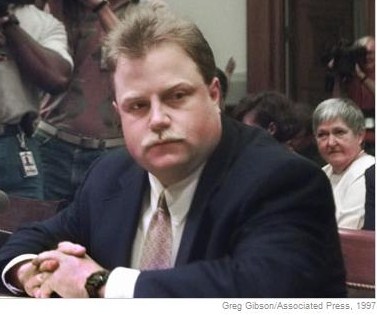 Richard Jewell became a household name in the mid-90s, after the FBI named him a “person of interest” in the Centennial Olympic Park bombing. (Credit: New York Times, the AP) |
The media literally camped out on the front yard of this modest, unassuming security guard, who became a household name. After 88 days, the FBI said Jewell was no longer being investigated. In 1998, the FBI announced its prime suspect was a white supremacist named Eric Rudolph, who remained a fugitive until his arrest in 2003. He was also charged with the bombing of abortion clinics in Atlanta and Birmingham and is serving a life sentence at the ADX Supermax federal prison in Colorado.
Jewell sued NBC, CNN, ABC and the Atlanta Journal-Constitution for defamation. NBC settled out of court for $500,000. ABC and CNN settled for undisclosed sums. Jewell’s suit against the AJC fizzled after a federal judge ruled that Jewell was a “public figure” rather than a private individual and would have to prove actual malice. (Of course, he wasn’t a “public figure” until the media made him one!)
When I suggested at the SPJ national convention in Washington in 1996 that we should adopt a resolution apologizing to Jewell, my colleagues reacted as though I had belched in church. One of them even rationalized to me that “the media did Jewell a favor by making him rich.” A year later, Attorney General Janet Reno did apologize to him. Jewell died in 2007 at the age of 44.
The media’s defense in the Jewell case was that they were just reporting what the FBI said. No one bothered to ask the FBI why it was not filing charges against Jewell, or why it was suddenly so cooperative with the media.
 John and Patsy Ramsey, seen in this screen shot from a CNN interview, were named “persons of interest” in the murder of their daughter JonBenét Ramsey for more than a decade, only to be cleared by authorities in 2008. (Credit: CNN, YouTube) |
The media obviously learned little from the Jewell travesty. That December, 6-year-old JonBenét Ramsey was found strangled in the basement of her family’s home in Boulder, Colo., and this time it was the local authorities, police and district attorney, who leaked to the media that her parents, John and Patsy Ramsey, were persons of interest.
Another trial by media ensued, but no charges ever were filed. Patsy Ramsey went to her grave in 2006, still protesting her innocence. We’ll never know whether the media pressure may have contributed to the ovarian cancer that killed her at age 49. Two years after her death, the Boulder DA’s office announced that DNA technology that had been unavailable in 1996 absolved any member of the Ramsey family in the girl’s death. Prosecutors said they were “deeply sorry” for placing them under “an umbrella of suspicion.” There were no apologies from the media that milked the story, of course. The murder remains unsolved.
Just one week after the Ramsey murder exploded in the media, station KXAS-TV in Fort Worth, Texas, reported that a 23-year-old woman named Nina Shahravan told Dallas police that Dallas Cowboy offensive tackle Erik Williams had raped her while his teammate, Michael Irvin, held a gun to her head. The Dallas police held a news conference on Dec. 31, 1996, reporting that the two players were rape suspects, days before a playoff game with the Carolina Panthers. Unlike Jewell and the Ramseys, Williams and Irvin were already high-profile public figures, and the national media had a field day (pun intended) with this sensational story.
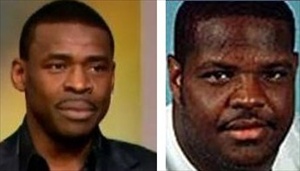 Left: Michael Irvin, left in a screenshot detail from a CBS video on YouTube, and Erik Williams, right in an image on a Dallas Cowboy fanclub site, were accused of rape, but the accusations were later recanted. |
But the sensation fizzled 10 days later when Shahravan confessed she had made the whole thing up. She was charged with perjury. At a news conference after their exoneration, an angry Irvin compared their ordeal to Jewell’s and accused the assembled reporters of not giving the same play to Shahravan’s recantation as they had to her false accusation.
”Rerun it, rewrite it, reprint it,” Irvin told them. ”Just like you did, with the same intensity that you did. The same intensity. Don’t lose the intensity. Don’t lose the intensity.”
Williams and Irvin sued KXAS for defamation of character, and although they are public figures, the station settled out of court on July 24, 1997, for a rumored $2 million. They apparently had sufficient evidence to meet the burden of proving actual malice by showing the station had showed reckless disregard whether the accusations were true or not.
(The Williams-Irvin case is remarkably similar to that of the three Duke University men’s lacrosse players in 2006, except that in the Duke case, District Attorney Mike Nifong did file formal charges, which are a public record, and thus there was nothing unethical about the media reporting on the charges. However, Nifong had no case, he later dropped the rape charge and was eventually disbarred for his handling of the case. North Carolina Attorney General Roy Cooper proclaimed the three players innocent in 2007. The lapse of ethics was on the part of the prosecutor, not the media.)
Then there was the trial by media in 1998 of Larry Grisham of Jacksonville, Fla. He lived five houses from 8-year-old Maddie Clifton, who disappeared on Nov. 3. For a week, the local police and the FBI let the media know that their prime suspect was Grisham, 45, who had twice been arrested for sexual battery, although the charges had been dropped. He was quoted by the Florida Times-Union as saying he had been chipping golf balls with Maddie 30 minutes before she disappeared. He also reportedly failed a lie detector test in the Clifton disappearance.
Aha! Obviously guilty as hell! For a week, Grisham’s name was dragged through the mud by the national media. I remember Lisa McRee, then co-anchor of ABC’s “Good Morning America,” demanding of a police spokesman, “Why hasn’t this man been arrested?”
Well, he wasn’t arrested because there wasn’t enough evidence to charge him, and he had an alibi. Then, a week after Maddie’s disappearance, a woman in the neighborhood discovered her body hidden in the waterbed of her 14-year-old son, Joshua Phillips. He was convicted of the girl’s murder in 1999 and is serving life without parole.
So much for rushing to judgment. And what about the harm done to Grisham’s reputation? Oh, who cares? Ratings are what’s important.
Remember Steven Hatfill? He’s the physician/biological weapons expert whom the FBI named as a person of interest in the mysterious anthrax mailings in the wake of 9/11. He lost his job as a researcher at Louisiana State University because of the notoriety. The FBI even invited the media to view the search of Hatfill’s apartment. Hatfill also was subjected to trial by media, but he was never charged.
Hatfill sued the government for the damage to his reputation and the government agreed to a payment of $5.8 million. He also sued The New York Times, but like Jewell, he was ruled a public figure and could not prove actual malice. Once again, the media lamely argued, “We were just reporting what the FBI told us,” as though that absolved us of any responsibility for besmirching the man’s reputation.
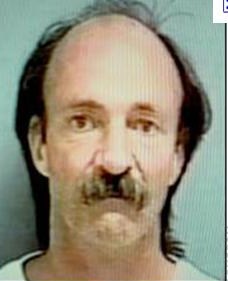 Richard Ricci, seen in his mugshot from TruTV, was named as a prime suspect in the Elizabeth Smart case. He died of a brain hemorrhage while in prison for a parole violation, two months after Smart’s disappearance. He was later cleared of her kidnapping articles. (Credit: TruTV) |
Let’s turn now to the well-known case of Elizabeth Smart, the Salt Lake City girl abducted from her own bedroom in June 2002. The case garnered nationwide media coverage, including on John Walsh’s “America’s Most Wanted.”
Salt Lake City police let the media know that their prime suspect, not just person of interest, was Richard Ricci, a ne’er-do-well who had worked for the Smart family as a handyman and who had recently been sent back to prison for a parole violation. He had been convicted of attempted murder of a policeman and of various burglaries, and with his connection to the Smarts, the media presumed his guilt. I remember his wife, Angela, being interviewed on “Good Morning America” and protesting his innocence, but that’s what all loyal wives do, right?
The police interrogated Ricci in prison, trying to pressure him into confessing to Smart’s kidnapping and to telling where she, or her body, was, while the media frenzy swirled around him and his wife. Suddenly, two months after Smart’s disappearance, Ricci suffered a brain hemorrhage and lapsed into an irreversible coma, dying soon thereafter. The country believed Smart’s kidnapper, and likely murderer, was dead. Well, so it seemed.
Oops! Seven months after Ricci’s death, in March 2003, police found Smart in the clutches of a polygamist whacko named Brian David Mitchell and one of his “wives,” Wanda Barzee, in Sandy, Utah. Both were convicted of her kidnapping.
Angela Ricci sued the state of Utah for wrongful death, and the state settled for $150,000. But what role did the media frenzy play in that wrongful death at the age of 48? Oh, who cares, the guy was a scumbag anyway, so the sentiment seemed to be, and it was a great story. Besides, the media, once again, were just reporting what the cops said and thus were absent malice, right? So, like Pontius Pilate, we washed our hands of Richard Ricci’s death.
Which brings us full circle to Terri Moulton Horman. Like Scott Peterson, who was also the subject of a trial by media in the disappearance/murder of his pregnant wife Laci in Modesto, Calif., in 2002, Terri Horman may eventually be arrested, charged, indicted, tried and convicted in connection with her stepson’s disappearance. But thus far, it is just rampant speculation, and the media coverage presuming her guilt is unprofessional and unethical. The determination of guilt in our system is supposed to be the job of prosecutors and a 12-member jury, not the media. The media are supposed to keep us informed of developments in the investigation.
Her case is not isolated. On Aug. 12, George Stephanopoulos reported on ABC’s “World News” the arrest in Atlanta of Israeli-born Elias Abuelazam. Stephanopoulos correctly stated that Abuelazam was arrested “in connection with” five stabbing murders in three states, and the reporter on the story said Abuelazam was “believed linked” to the murders.
But the accompanying super declared “Killer Caught.” Maybe, but that’s a jury’s, not ABC’s, call to make.
Such declarations of guilt by the media make finding an impartial jury increasingly difficult. The media, which always stand on their First Amendment rights in reporting police leaks, hearsay evidence, false accusations, speculation or outright rumors in sensational criminal cases, need to remember that there are other amendments in the Bill of Rights as well.
The media also should stop looking gift horses in the mouth and ask questions anytime the FBI, local police or district attorneys, who normally stonewall the media, suddenly become so generous in providing information about people on whom they lack evidence to charge and who may well be innocent. Just because we can hide behind the almost unassailable legal bastion of actual malice doesn’t mean that it’s ethically correct to sully the reputation of someone who hasn’t even been charged.
Moreover, is it just coincidence that Richard Jewell, Patsy Ramsey and Richard Ricci all died in their 40s?
The SPJ Code of Ethics says “minimize harm,” not maximize it!
 |
ROBERT BUCKMAN, Ph.D., is an associate professor of communication and head of the print journalism sequence at the University of Louisiana at Lafayette. He is a member of both the Ethics Committee and the International Journalism Committee of the Society of Professional Journalists. He is the author of a reference book on Latin America and a regular freelance contributor to newspapers on Latin American politics. |
CORRECTION - October 10, 2010 08:10 AM
An earlier caption relied upon the super title in the above news video to identify stepmom Terri Horman. A sharp-eyed reader pointed out to us by email that it misidentifies DeDe Spicher, friend of stepmom, as the stepmom, Terri Horman . We regret the error and are grateful to the reader for letting us know.







Great article. Thanks for that point of view. I was listening to the radio one night and the talk show host (Randy Roads) said that there hasn’t been any news since the OJ trial in 94. Seems about righ to me.
What really gets me is that you never hear when the suspect is exonerated like Irvin said.
One question I have is what is the cost to the media for being wrong. With the settlements they have lost is this a drop in the bucket to what they have gained in terms of the initial coverage and ratings. How would one measure this?